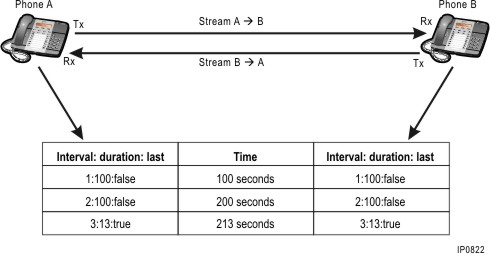
Voice quality statistics are stored as records (called "intervals") of 100 seconds or less in length. They record the events that occur between IP endpoints that have established voice streams in each direction (see diagram below). There is a separate set of intervals recorded for each stream. For example a call of 213 seconds length, would consists of two 100-second intervals, and one 13-second interval (the last interval).

Note: The 3300 ICP has a temporary cyclic database of 5000 statistics records that is archived on the Enterprise Manager. When you display statistics using the Voice Quality Statistics form, you are seeing a "snapshot" of the last 5000 records. For statistics that extend farther back, you must use the report generation capabilities of Enterprise Manager or Viola Netally.
For more information:
The voice quality statistics form reports the following statistics for supported IP phones:
|
Field |
Description |
|
Sequence Number |
A system-generated number indicating the consecutive arrival of statistic reports from IP end points. |
|
Interval Start |
Time and date of the report interval. |
|
Interval Number |
A IP end point-generated number identifying the particular consecutive interval report during an extended IP voice stream |
|
Directory Number |
The directory number of the phone that is gathering statistics. This field is blank for E2T statistics. |
|
Packets Received |
The number of packets received in an interval. |
|
Packet Loss |
The total number of lost voice packets per interval. |
|
Average Jitter (ms) |
Average interval jitter value (ms). |
|
Delay(ms) |
Total transit time for a voice packet from the voice stream source to the destination. |
|
Interval Length (sec) |
The length of the interval in seconds. Usually 100 seconds (the final interval may be less). |
|
Last Report |
Indicates if the interval is the last report in the stream. |
|
MAC Address |
The Media Access Control (MAC) address of the IP end point. |
|
IP Address |
The IP address of the endpoint. |
|
Voice Port (UDP) |
The UDP port number used to receive voice streams. |
|
Signal Port (TCP) |
The port used by the receiving device for MiNet messaging with the 3300 ICP. |
|
Subnet |
The IP address of the subnet containing the IP end point. |
|
Far End IP Address |
The IP address of the far end IP end point. |
|
Far End Voice Port |
The destination UDP port for the voice stream. |
|
Endpoint Context |
Indicates if the endpoint is one of the following: a directly connected IP set, an E2T, or a Teleworker. |
|
Endpoint Type |
Device type, for example, the 5235 IP phone. |
|
CODEC |
The last CODEC used in the call. Possible values include: G711-ulaw, G711-alaw, or G729a. |
|
Maximum Jitter (ms) |
Maximum jitter value in milliseconds during report the interval. |
|
Jitter Histogram (10-19 ms) |
The number of incidents of jitter within 10-19 ms. during the report interval. |
|
Jitter Histogram (20- 39 ms) |
The number of incidents of jitter within 20- 39 ms. during the report interval. |
|
Jitter Histogram (40-59 ms) |
The number of incidents of jitter within 40-59 ms. during the report interval. |
|
Jitter Histogram (60-99 ms) |
The number of incidents of jitter within 60-99 ms. during the report interval. |
|
Jitter Histogram (100-199 ms) |
The number of incidents of jitter within 100-199 ms. during the report interval. |
|
Jitter Histogram (>199ms) |
The number of incidents of jitter greater than 199 ms during the report interval. |
|
Jitter Buffer Overflow |
The number of audio packets discarded due to excessive jitter during the report interval. |
|
Jitter Buffer Underflow |
The number of silent packets inserted while the jitter buffer is empty because packets were delayed or missing during the report interval. |
|
Jitter Buffer Average Depth |
Indicates how much of the adaptive buffer is used on average. |
|
Jitter Buffer Max Depth |
Indicates the maximum depth the adaptive buffer had to accomodate at the worst jitter over the interval. |
|
Packet Loss Max Burst |
Maximum number of consecutive packets lost per interval. |
|
Packet Loss Histogram (1 packet) |
The number of incidents of 1 lost packet during the report interval. |
|
Packet Loss Histogram (2 packets) |
The number of incidents of 2 consecutive, lost packets during the report interval. |
|
Packet Loss Histogram (3-5 packets) |
The number of incidents of 3-5 consecutive, lost packets during the report interval. |
|
Packet Loss Histogram (6-10 packets) |
The number of incidents of 6-10 consecutive, lost packets during the report interval. |
|
Packet Loss Histogram (>10 packets) |
The number of incidents of 11 or greater consecutive lost packets during the report interval. |
|
Packets Out Of Order |
The number of packets that arrived out of order during the report interval. |